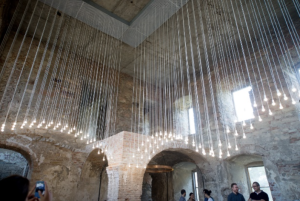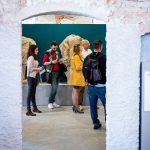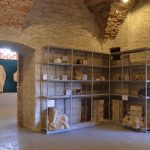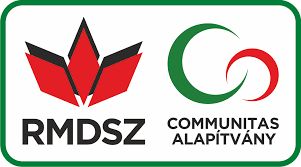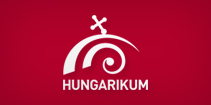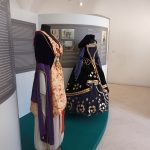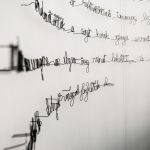Permanent Exhibitions

Lost&Found. Lapidarium, located in the castle gatehouse, presents the lost (stolen, damaged) and later found (cleaned, partially restored) sculptures of the former statue gallery and carved stone decoration of the building ensemble. Of the more than half-a-hundred pieces of the Baroque statue gallery, only a few pieces have survived the vicissitudes of the 20th century. The statues and stone carvings found in the lapidarium were found during the restoration works carried out at the castle, and a further six pieces were put at the lapidary’s disposal by the Transylvanian National History Museum.
The statue gallery of Bánffy Castle, Bonțida, is Transylvania’s most significant 18th-century sculpture ensemble. Its creation is linked to the castle’s expansion works carried out in the 1740-50s by Count Dénes Bánffy, who wanted to decorate his residence according his rank, in a way that would resemble Viennese aristocratic buildings. He entrusted the work to sculptor Johannes Nachtigall from Cluj, who, when modelling his figures – mythological heroes, titans, and gods – drew inspiration from the Roman poet Ovid’s Metamorphoses. In addition to the statues of the main building and the court d’honneur, carved urns with figurative elements completed the decoration of the mentioned building façades. Other decorations included two representative gates, with the statue of a groomsman on a prancing horse above the entrance to the riding school and the relief of a horse above the entrance to the stables. The life-size horse statue of the stable’s fountain, as well as the urns and statues in the castle park are also part of the sculpture collection.
The Lost&Found. Lapidarium exhibition was created with the involvement of young art historians, architects, visual artists, designers and project managers.
The exhibition can be visited daily between 10:00 and 18:00 ⃰.
⃰ For information about the castle’s opening hours, please follow our pages (Facebook, website).

The trilingual exhibition MIKLÓS BÁNFFY’S FORCE FIELDS presents the wide-ranging cultural and political activity of Count Miklós Bánffy, former owner of Bánffy Castle, Bonțida, in the most representative part of the castle, which served as the family’s residential area for centuries. The exhibition explores across five rooms the geographical and spiritual “force fields” that stood at the basis of the Count’s lifework. As there is no comparable undertaking to document and represent this remarkable life and work as a permanent exhibition, our initiative is essential and of prime importance.
The exhibition offers a unique experience to children and adults alike, combining traditional museum elements with digital content and using tactile as well as multimedia tools to illustrate the Count’s multi-faceted personality and the various aspects of his activities: the politician, writer, opera director, set designer, theatre director, graphic artist, caricaturist or even the family man, combined with an exploration of the former splendour, destruction and decay, as well as rebirth and revitalisation of Bonțida Castle. The digital content is accessible via the visitors’ smartphones; however, tablets are also available at the reception.
The exhibition is open every Saturday and Sunday from April to October between 11:00 and 17:00 ⃰.
Curator of the exhibition: Eszter Apor
Design, installations, implementation: Atelier MASS – Cluj-Napoca, Art Bending – Cluj-Napoca, IDEA-Plus – Cluj-Napoca, Nurb Concept – București, Pro Restauratio – Cluj-Napoca
Expoziția a fost realizată cu ajutorul și contribuția următoarelor persoane și instituții:
Institutions: Asociația Carola – Cluj-Napoca, Eparhia Reformată de pe lângă Dunăre, Arhiva „Ráday” – Budapesta, Muzeul Național de Istorie a Transilvaniei – Cluj-Napoca, Biblioteca Capitalei „Szabó Ervin” – Budapesta, Institutul „Liszt” – Sfântu Gheorghe, Opera Maghiară de Stat – Budapesta, Muzeul Național Maghiar – Budapesta, Academia Maghiară de Științe – Institutul de Cercetare Filologică, Colecția Institutului de Istoria Artei – Budapesta, Biblioteca Națională „Széchényi”– Budapesta, Muzeul de Literatură „Petőfi” – Budapesta, Universitatea Sapientia – Cluj-Napoca, Muzeul de Artă – Galeria Națională – Budapesta, Muzeul Institutului Național de Istoria Teatrului – Budapesta, Muzeul Zempléni – Szerencs
Private individuals, researchers: Ailisha O’Sullivan, Dr. Bartos-Elekes Zsombor, Dán Barna, Bánffy-Jelen Nicolette, Dr. Barcsay Tamás, Dr. Berki Tímea, Gy. Gercsák Gábor, Gy. Dávid Gyula, Dr. Rus-Cacovean Ioana, Szabó-Szebeni Róbert, Szebeni Zsuzsa, Veégh Daray Erzsébet
Sponsors:
⃰ For information about the castle’s opening hours, please follow our pages (Facebook, website).

Since 2016 the castle has become the location and inspirational context of creative residencies. The international participants rediscover and reinterpret the meanings of the history, spirituality, values and patterns of the place, meanwhile their creations combine artistic expression with crafting skills. The interactive artworks, installations can be visited in the interiors of the castle and in the courtyards around it.



